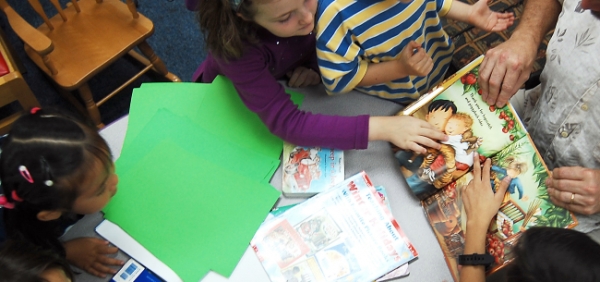"Once pupils have learned how to read, they often opt out."
If you’re reading this article, it’s likely you have noticed that your students are really not always that keen on reading. You might be concerned that they are falling behind as readers and writers. You might be thinking in particular about pupils who have been diagnosed with some type of learning challenge, such as ADHD or dyslexia. Or, you might have English as a second language (ESL) in your classroom who are fluent in one or more languages, but who are struggling to learn English.
To better understand why many children of average and above-average intelligence have difficulty learning to read, we need to consider how hard it is for young learners to make sense of small squiggles on a page. To be able to associate sounds with letters, to combine letters to make words, and combine words to make meaning. In other words, as researcher Paul Kropp summarises:
“Between the ages of four and nine, your child will have to master some 100 phonics rules, learn to recognise 3,000 words with just a glance, and develop a comfortable reading speed approaching 100 words a minute. He must learn to combine words on the page with a half-dozen squiggles called punctuation into something – a voice or image in his mind that gives back meaning.” (Kropp, 1996)
Today’s children are more likely to be hooked on cool apps and games than on the Jolly Postman or Lemony Snicket and colourful, if unfortunate events. While young children are often avid readers, ironically, once they have learned how to read, they often opt out, spending only a few minutes each day reading on their own.
We need to find ways to entice children to read—a lot! As Dr. Marilyn Jager Adams points out: “If we want children to learn to read well, we must find a way to induce them to read lots,” and likewise, “If we want to induce children to read lots, we must teach them to read well” (Beginning to Read, 1994).
How can we help children learn to read well and often? Here are ten classroom-tested ideas.
1. Make It a Party Every Time You Share a Book with a Child
Every time we read with children, we have an opportunity to interact in fun ways using dialogic reading techniques. Dialogic reading is a playful, interactive way of sharing a book that is hugely beneficial for children. Rather than zipping through a book, doing a “straight read,” with dialogic reading the child become the teller of the tale - or the sharer of new information in the case of nonfiction titles.
In short, dialogic reading gives you an opportunity to do things like: listen, ask questions, encourage the child to act out a scene, and “become” a character from the book.
Research indicates that children who have been read to dialogically are substantially ahead of children who have been read to traditionally on tests of language development. Studies also show that children can jump ahead (in terms of reading proficiency, including vocabulary development) by several months after just a few weeks of dialogic reading. Give it a try.
2. Partner with Parents
Parents are your best allies in helping your students learn to read. Full stop.
Parents can entice children to want to read well beyond the school day. They can encourage children to read their original stories and do dramatic readings. They can also read aloud books, that children are excited about but aren’t yet ready to read on their own, such as Harry Potter.
Invite families into your classroom to read with children. Demonstrate for them how to read dialogically (see above). Call on volunteers to share their strategies for encouraging children to enjoy books at home. Then ask whether they can commit to having their child read for enjoyment at least twenty minutes a night, four nights a week.
Make a list of ideas parents come up for reading at home with and share it via email or your class blog.
3. Expose Children to Lots of Nonfiction Books
Children like to know things. They enjoy becoming experts. Maybe it all starts with dinosaurs. Then snakes. Then volcanoes. Then the geography of the world. Next up: the universe.
Make sure to fill your bookshelves with as many nonfiction titles as you can manage on all the subjects your students are curious about.
Follow up with inquiry-based projects based on what they want to learn next, tapping into websites such as NASA, Science, the British Museum, and BBC’s History for Kids.
4. Keep a Literature Journal
Literature journals offer children a way to express themselves while they’re in the throes of a good book. Pupils can jot down their responses to character, plot, setting - and whatever strikes them as funny or interesting - while they’re reading a book they enjoy. When children respond to new ideas in writing, even in just a few sentences, it helps them deepen the sort of immersive experience that a book can provide. Extra points for noting new and challenging vocabulary words and their meaning(s).
Collect the literature journals once a week and write a few comments. Or have children swap their journals with a classmate and talk about the book they’re reading.
5. Mystery Authors
Children are often stunned to learn that authors are living, breathing, human beings. Working in teams or small groups, have children research their favourite author, using book jacket copy as well as author and publisher websites.
Culminate the project by having children dress up as their favourite author. Have them write five clues about their chosen author and see if their classmates can guess his or her identity.
6. Have Children Write their Own Books
Writing a spin-off or a sequel for a favourite book offers children a chance to develop their comprehension, creative, and analytical skills. What if Jack of Beanstalk fame had not traded his cow for magic beans? What might have happened then? Would everything have gone perfectly, or would Jack have had other misadventures?
Or, how else could the Three Little Pigs have outwitted the wolf?
Encourage pupils to write their own books, then share them with classmates—and the larger world. If possible, have them create their books using word processing software and digital art tools. Or, if you have access to iPads, show children how to use a writing app such as Book Creator.
7. Create a TV Commercial to Advertise a Favourite Book
What are the selling points of a book that a student loves? Is it exciting, scary, funny, adventurous? Thinking about questions such as these helps children develop their comprehension and analytical skills. It also helps them be able to summarise complex ideas.
Lead a discussion with pupils about the selling points of various books you’ve shared together. Then have them write an advertisement to entice classmates to read a book they think is terrific. How can they say just enough, without giving too much away? What types of readers would especially enjoy this story or information book? They need to be sure to consider their audience.
If you’re able to film students on smartphones or other devices, have them take turns filming each other as they give their pitch. Feature the videos at an evening for parents and/or a school-wide literacy event.
8. For the Love of Words
Children who have a rich vocabulary have an excellent shot at understanding and interpreting what they read. While children learn many words indirectly (eg by encountering them several times), they also benefit from direct instruction, focused on new and interesting words they’ve come across in their reading.
"What if Jack of Beanstalk fame had not traded his cow for magic beans?"
One strategy for direct instruction involves creating Word Webs. These networks of words help children process the meaning of new vocabulary on a deep level. Begin by helping children generate a network of words that are related to the target word. If the new vocabulary word is scared, for example, create a Word Web by placing scared in the center of a web, with related words - such as “frightened”, “afraid”, “shaking in his boots”, and “fearful” - radiating out from the new word.
Then have pupils zero in on a few interesting and challenging words of their choice. Working in teams, have them create Word Webs to share with the class. Extra points for adding illustrations! Post their Word Webs around the room for extra exposure to the new vocabulary words. Or, if your students love crossword puzzles, have them create their own, using Discovery Education’s Puzzlemaker (Extra cool, since to create puzzles, children will get extra practice in spelling the target words and composing a definition).
Most importantly, encourage pupils to use the new word in a sentence that demonstrates their understanding of its meaning.
9. Blog About Your Students’ Work
Get word out. Let parents know what their children have been studying so they can reinforce learning at home. If you don’t yet have your own blog, don’t worry. With so many educational bloggers willing to share their expertise, it’s relatively easy. Edech star Steven Anderson, for example, says that blogging is an important part of his practice. For today’s students, he continues, “ ...the audience is global and anyone can read, and in some cases respond and comment. Kids can post their writing projects, thoughts and reflections. Teachers can provide prompts or starters and kids can pick up and run with it.”
If you’re not already blogging, check out the “getting started” sections of these two platforms: Edublogs and Kidblog. For more tips and tricks, see Steven’s blog post.
10. Go Global
When it comes to finding an authentic audience for you students’ writing projects, think big. Have students select their best story or nonfiction article and go global, showcasing their work for an international audience.
Check out Pobble, a free website created by innovative teachers in Yorkshire. As of this writing, Pobble has over 30,000 pieces of writing, with over 100 countries represented. Read more in this article in Schools Week.
* * * * *
Above all, keep in mind your end goal: To create lifelong readers and writers who love books and learning, and who feel connected in meaningful ways well beyond classroom walls.
How do you go about getting pupils invested in literacy? Share your tips below.


















